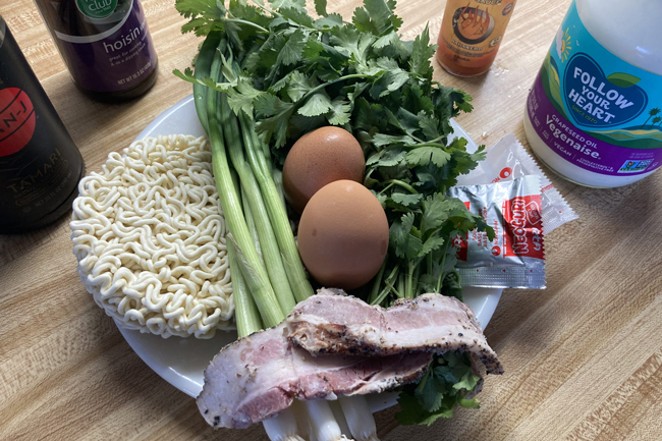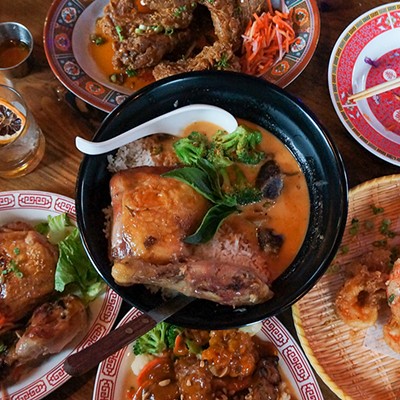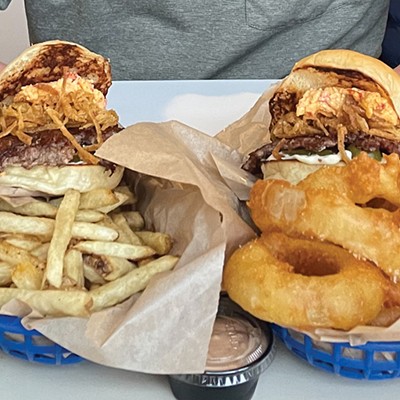Instant ramen noodles have replaced cigarettes as the reserve currency of the incarcerated. They are available at most prison commissaries for about 60 cents each, providing you have money in your account. Inmates convert their dollars to ramen the way speculators pile into the latest cryptocurrency, and trade the packages of crispy noodles for clothes, drugs, bribes, favors, and anything else of value. Unlike crypto, instant ramen is a real, physical thing that you can hold in your hand. It's durable, portable, divisible into units, can be neatly stacked, and has intrinsic value because of its calories and flavor – both of which are scarce in most prison meals.
"You gotta have ramen," writes Gustavo Alvarez, author of the Prison Ramen Cookbook. His instant ramen-based recipes include the likes of the Prison Burrito, Prison Tamale, Ramen Salad, Ramen Sandwich, and Orange Cracklin Ramen (with pork rinds and orange Kool-Aid).
Like every other ramen chef on the planet, I too have my tricks and techniques for using ramen as an ingredient in something greater. We'll get there in a moment. But first let's first review some ramen history, some of which rhymes with today's news.
Instant ramen noodles were invented in the wake of the second World War. Most of Japan's cities had been bombed. Its infrastructure was wasted, and winter was coming. As the U.S. sent boatloads of wheat to its vanquished adversary, Japan's ministry of health struggled to encourage bread baking. That's when a Taiwainese-born Japanese citizen named Ando Momofuko began trying to invent instant ramen. Momofuko finally came up with the technique of flash-frying fresh noodles in hot oil, which caused perforations in the dehydrated noodles that allowed them to rehydrate quickly. The debut of Chikin Ramen in August 1958, ushered in a new era of customizable high-calorie convenience.
"The genesis of instant noodles marked a turning point in Japan's history, mirroring its rise from a struggling nation to a modern economic powerhouse," writes Celia Hatton for the BBC. "They came of age when Japanese households were filling up with new products. Electric kettles made it easy to cook instant noodles, commercials for which were broadcast into newly middle-class homes on brand-new televisions. In 1956, only one per cent of Japanese households had a TV. Four years later, almost half had one." Ramen has repeatedly been voted the nation's most successful invention, ahead of high-speed trains, laptops and LED lights, Hatton adds.
Hatton credits instant ramen with helping fuel three decades of growth in China, the world's largest market for instant ramen. Demand is highest among migrant workers who've left their homes in the countryside to work in the country's factories and cities, she writes.
With the Ukraine war raging and wheat prices rising, the cost of ramen will probably climb. For most of us, especially those under attack, it's the least of our worries. But inflation being the beast it is, the most vulnerable will feel the squeeze hardest—none worse than prison inmates earning sub-minimum wage. But if we need a reminder that light will follow darkness, look no further than ramen itself. It came from Japan being bombed and nuked to near-oblivion and helped fuel its rebound. Momofuko, who lived to be 96, attributed his health to daily servings of Chikin Ramen. It's a viable path forward.
Lately, when making ramen, I have been channeling southeast Asian-style noodle soups like pho. These brothy soups are typically served alongside a mount of fresh herbs and vegetables, to be heaped into the soup at the last minute. I also keep condiments like vinegar, hot sauce and hoisin sauce within reach.
Ramen Tactics
Your first choice is which brand and flavor of ramen to use. The original Top Ramen, made by Momofuko's Nissin corporation, is no longer the best. I believe the highest quality instant ramen these days comes from South Korea—my favorite being Nongshim brand. Of those, I like the Neoguri spicy seafood and Shin spicy beef.
Ideally, I like to have the following additional ingredients on hand:
• Bacon, tofu or other proteins like fake crab, leftover BBQ, frozen shrimp or scallops
• Fresh veggies like spinach, broccoli, radish
• An egg or two
• Fresh herbs like cilantro and green onion
• Condiments like hoisin, hot sauce, vinegar, mayo, minced garlic, etc.
I add the flavor packet, or packets, to the cold water as soon as I turn on the heat. I add the noodles soon after—I don't see the need to wait. I'll add my proteins right off the bat, too. Ramen is pretty much the only context I can think of where soggy bacon is acceptable, as it resembles the floating slice of soft pork in a bowl of high-end tonkatsu ramen. Ideally the bacon is mild flavored, so it won't take over the soup. Rather, it should be subtle and satisfying, and make you happy when you chew it.
The egg should be soft and runny, but not gooey. I crack the egg into a bowl first, so I can then simply pour it exactly where I want it, and don't have to worry about breaking the yolk. When the noodles are starting to fall apart, I add the spinach directly on top of them to form a nest of noodles and leaves to cradle the egg when I pour it into the nest. Sometimes I use a spoon to support the nest from underneath for the first few crucial moments after adding the egg, giving it a chance to grab onto the nest materials and solidify. If using minced garlic as a garnish, you can add it now or a little bit later, depending on your tolerance.
While the egg is cooking, add the chopped white parts of the green onion to the pot. Save the green parts to add with the cilantro.
If your timing is right, the noodles and egg reach their ideal states at the same time. Serve by carefully scooping the noodles, veggies and proteins into a bowl, and pouring the broth over the noodles. Next, add the cilantro and green onion leaves. Fine tune your bowl of noodles with your condiments.























